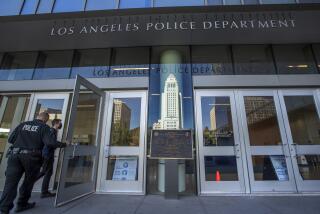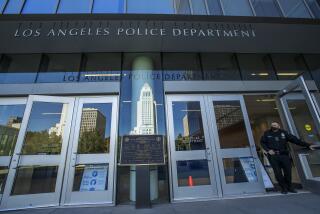Police Panel Endorses Limits on Use of Flashlights
- Share via
Six months after live television caught a police officer beating a car thief with a heavy metal flashlight, the Los Angeles Police Commission has proposed a policy that discourages their use as a baton except in “exigent circumstances.”
The policy, unveiled at a Police Commission meeting Tuesday, dictates the use of a flashlight for “illumination.” Use as a weapon on suspects is permissible only in emergencies.
“This policy makes clear flashlights are for illumination and discourages their use as an impact tool. And it ensures officer safety as well as protects the public,” said Alan Skobin, commission vice president. “Officers don’t mind being held accountable as long as they have a clear policy to follow, and that’s what we’re providing here.”
The proposal, to be considered Jan. 11, stops short of the near-total bans on use of flashlights as weapons that some large cities have adopted. Skobin said the commission wants input from all interested groups.
The proposal appears to allow officers to use flashlights to stop violent suspects, said Bob Baker, president of the Los Angeles Police Department officers union, the Police Protective League.
“We support policies that, at the end of the watch, mean we are going home safe,” Baker said.
LAPD officers should have the means and the training to safely restrain violent and resisting suspects, he said.
“It seems a bit unfortunate they have to make a policy on how to use or not use a flashlight,” said Ricardo Garcia, criminal justice director of the American Civil Liberties Union of Southern California.
“This is a good start. But I’d like to see them move away from even this permissive a use of flashlight,” Garcia said. “On the positive side, at least this will give officers some training on how if they’re going to strike with a flashlight to do it. Before this, they could pretty much do anything.”
“This is a step in the right direction. It is a thoughtful and reasonable policy,” said Los Angeles Urban League President John Mack. “They certainly needed a policy on governing the use of a flashlight as a weapon.”
The policy is the second flashlight-related reform since the June 23 televised beating of Stanley Miller. Officer John Hatfield struck Miller 11 times at the end of a high-speed pursuit that turned into a foot chase along Compton Creek, leading to widespread outcry over the amount of force used to subdue him.
The LAPD at the time had no formal policy on the correct use of a flashlight to subdue a suspect.
Shortly afterward, Chief William J. Bratton announced he would forbid the use of heavy metal flashlights like the one wielded by Hatfield. He said the department would develop its own small, lightweight rubber flashlight, a process still underway.
Any use of flashlights as weapons would require written explanation and critical review, according to the proposal.
Officers would be required to avoid striking the head, neck, groin, spine and kidneys.
Primary targets should be bony areas such as the shins, knees, elbows and hands, the training program directs.
The district attorney’s office is reviewing the officers’ action in the Miller case, and six officers who were involved have been assigned to duty at their homes pending a resolution.
Since the beginning of 2002, there have been at least 48 incidents in which LAPD officers wielded flashlights against suspects. During training, officers were told they were permitted to use a flashlight as an “impact weapon” on aggressive or combative suspects for defensive purposes
In recent years, many of the largest urban police departments have moved to prohibit the use of flashlights as weapons in most circumstances out of concern that the heavy metal objects could cause more serious injuries than batons.
The New York Police Department, the nation’s largest, prohibits the use of flashlights or radios as “impact weapons” except in life-or-death situations.
A 1985 study in the Journal of Police Science and Administration found flashlights caused more injuries than police batons. More recently, a study by the National Institute of Justice found officers nationwide were more than twice as likely to use a flashlight as a weapon than a baton.
More to Read
Sign up for Essential California
The most important California stories and recommendations in your inbox every morning.
You may occasionally receive promotional content from the Los Angeles Times.











